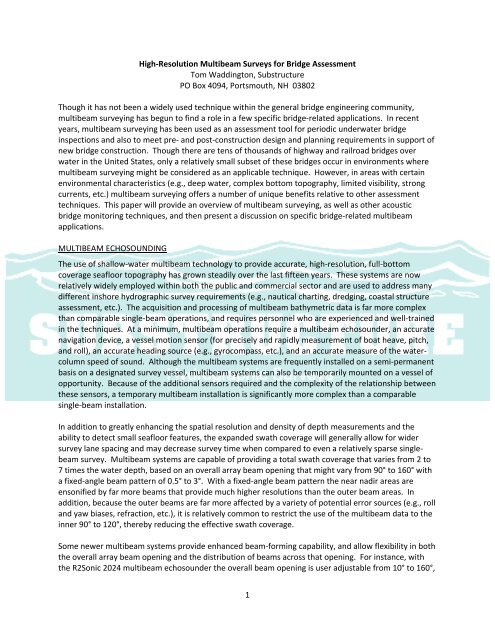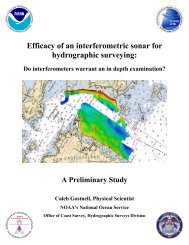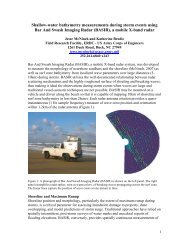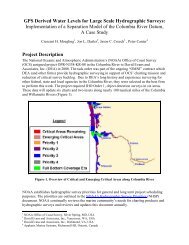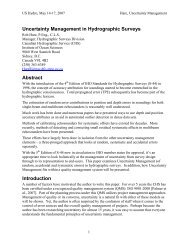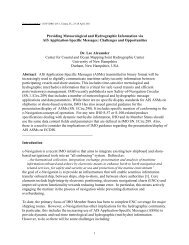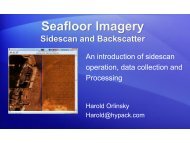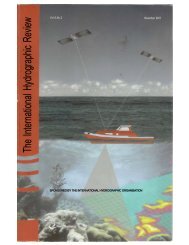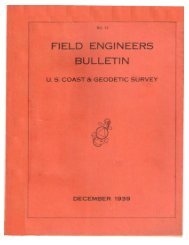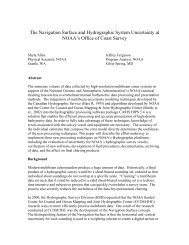High-Resolution Acoustic Multibeam Surveys for Bridge Assessment
High-Resolution Acoustic Multibeam Surveys for Bridge Assessment
High-Resolution Acoustic Multibeam Surveys for Bridge Assessment
You also want an ePaper? Increase the reach of your titles
YUMPU automatically turns print PDFs into web optimized ePapers that Google loves.
with all 256 beams focused within the selected opening angle. In addition, the individual beams can be<strong>for</strong>med based on either an equal‐angle or equal‐distance preference. The equal‐distance mode enablesthe individual beam angles to be varied across the opening to provide consistent spacing of the beamfootprints across the seafloor. As opposed to the more standard equal‐angle beam pattern, the equaldistancemode focuses far more beams in the outer‐swath areas and provides more consistent coverageand resolution across the entire swath opening. These types of systems can be particularly useful inbridge surveying applications <strong>for</strong> providing consistent coverage along the structural supports.Proper installation of the multibeam sonar, as well as tight integration with the other peripheral sensorsis critical to ensuring the accuracy of the multibeam survey results. Although the acquisition ofmultibeam data can proceed rapidly once the system has been properly installed and calibrated, theprocessing of the data can be a more time‐consuming ef<strong>for</strong>t, particularly in areas of high vertical relie<strong>for</strong> significant water‐column interference. As will be discussed later, editing multibeam data that hasbeen acquired around bridges can be particularly challenging. After the various multibeam sensor datahave been edited and verified, the sounding data are reduced to a vertical datum (e.g., MLLW, NAVD88,etc.) based on water‐level correctors developed from accurate elevation data acquired on the surveyboat or local observations. After the bathymetric data are fully edited and reduced to a datum,comparisons are then made on the areas of overlap that are generally seen in multibeam datasets.Eventually, the multibeam data are gridded based on desired resolution and file size constraints, andthen exported to a GIS <strong>for</strong> additional analysis, visualization, and integration with other data types (Figure1).In addition to high‐resolution bathymetry, most multibeam systems are capable of acquiring acousticbackscatter intensity data that provides useful in<strong>for</strong>mation <strong>for</strong> helping to characterize seafloorsediments. Handled similarly to side‐scan sonar data, multibeam backscatter data are typically mergedto create imagery mosaics that are used to help delineate and distinguish areas of differing seafloorsediments (Figure 1). For target detection, the resolution and image quality of multibeam backscatterdata may be somewhat lower than true side‐scan sonar data, primarily because of steeper grazingangles; the multibeam transducer is typically mounted on or near the survey vessel, while the side‐scansonar transducer is housed in a towfish that is maintained closer to the seafloor. For general seafloorcharacterization, multibeam backscatter data offer some advantages over side‐scan sonar data. Thepositional accuracy of the backscatter data is usually much better because of the fixed and well‐knownlocation of the transducer, as well as the accurate vessel heading and motion data that are alsoacquired. In addition, the backscatter intensity data can usually be normalized across the swath byaccounting <strong>for</strong> sonar settings, beam angle geometry, and seafloor bathymetry. This produces datasetsand mosaics that are more consistent and easier to analyze through either manual or automatedmethods.OTHER ACOUSTIC SURVEY TECHNIQUESOther acoustic remote sensing sensors that have also been used to support bridge‐related surveyingapplications include single‐beam echosounders, side‐scan sonars, and sector‐scanning imaging sonars.Even with the relatively recent advances in shallow‐water multibeam technology, there are stillapplications well suited <strong>for</strong> single‐beam bathymetry and it remains an accurate, low‐cost, and relativelysimple technique <strong>for</strong> generating seafloor topography. For many years, single‐beam “fathometric” surveyshave been a standard requirement within many underwater bridge inspection programs. In theseapplications, the single‐beam data has been used to develop general bathymetry around the site of thebridge and to make an initial assessment on scour. However, based on the lane spacing used during data2
acquisition, single‐beam bathymetric survey data will typically cover only 5‐10% of the total seafloor area(Table 1). Subsequent analysis and gridding tools can still be used to generate a three‐dimensionalseafloor surface model with this relatively sparse data, though a large degree of interpolation between thediscrete survey data points will be required. Though this interpolation might work well in flat or gentlyslopingareas, in steep or irregular areas the interpolation will be much less reliable and the resultingsurface will not accurately reflect the true bathymetry. In addition to the much sparser data coverage, thesingle‐beam techniques also provide no capability <strong>for</strong> acquiring data along vertical surfaces such asunderwater bridge supports.Side‐scan sonar imaging has been used extensively over the last 30 years to provide a relatively quickand complete acoustic image of the seafloor surface, as well as to reveal the size and location of distinctobjects on the seafloor. Side‐scan sonar data and the resulting imagery mosaics provide a plan‐viewmap image of the bridge area that can be useful <strong>for</strong> imaging bridge structural supports and alsoidentifying debris and other objects around the supports (Table 1). However, because it is basically atwo‐dimensional map product, the side‐scan sonar data is not useful <strong>for</strong> quantitatively evaluatingbathymetry or scour around the structures or assessing the vertical faces of the underwater bridgesupports.In recent years, sector‐scanning sonars have become more commonly used as a bridge inspection toolprimarily to generate high‐resolution acoustic images of the faces of individual structural supports(Table 1). The sector‐scanning sonars typically operate at higher frequencies than the other sensorsdiscussed and are capable of providing high resolution acoustic images that are commonly used <strong>for</strong> realtimeobstacle avoidance on remotely operated vehicles (ROVs), small item detection, diver guidance,and structural assessment. Unlike the other systems that have been discussed where data is typicallyacquired from a moving vessel, development of the high‐resolution sector‐scan images requires aseparate stationary set‐up <strong>for</strong> each of the images produced. For this reason, sector‐scanning sonars areviewed more as a higher‐resolution imaging tool as opposed to a broader‐scale mapping tool. Thoughgeo‐referencing of data points and generation of point cloud datasets is possible with sector‐scanningsystems, it is a more complex operation, requiring additional hardware and software. For bridge‐relatedapplications, the primary focus <strong>for</strong> the use of sector‐scanning sonars has been in acquiring highresolutionacoustic snapshots of the faces of underwater structural supports.A general comparison between these different acoustic survey techniques shows that each of thesemethods offers some trade‐offs between cost, complexity, and types of data products that are produced(Table 1). Of these acoustic survey techniques, multibeam echosounding has probably had the leastdirect use in bridge‐related survey applications, primarily due to the relative newness of the technology,as well as the complexities and related costs associated with conducting a high‐quality multibeamsurvey. Not only are there greater hardware requirements, but it is also more of a technical challenge toproperly install, integrate, and operate the equipment. However, once the system is properly set‐up,multibeam echosounding can be used to efficiently acquire dense, fully geo‐referenced datasets <strong>for</strong> theareas around the bridge, including each of the underwater structural supports. The resulting datasetscan be used to generate gridded high‐resolution bathymetric surfaces in the areas around the bridge, aswell as dense point‐cloud datasets of the structural supports. The gridded bathymetric surface productsare useful <strong>for</strong> evaluating the complete area around the bridge and making an assessment of scourpatterns, while the point cloud products are useful <strong>for</strong> a more detailed evaluation around each of thestructural supports.3
MULTIBEAM SURVEY CHALLENGES AROUND BRIDGESEven with a properly integrated multibeam survey vessel, there are some unique challenges presentedwhen trying to complete a high‐resolution multibeam survey around a bridge. Almost all high‐resolutionmultibeam surveys rely on real‐time kinematic (RTK) differential Global Positioning System (RTK DGPS)data <strong>for</strong> tracking precise vessel position and elevation during the survey. In most cases, the overheadbridge deck creates an intermittent obstruction to at least some part of the GPS constellation thatusually results in a short‐term degradation in the GPS position and elevation quality. The impacts of theshort‐term degradation in GPS quality can vary greatly depending on a number of factors (e.g., numberof available satellites, size and height of bridge, survey line orientation, etc.). Around bridges where theoverhead obstruction might be particularly extensive, there are other positioning techniques (e.g.,acoustic Doppler Velocity Log (DVL) bottom tracking, laser range/azimuth tracking, etc.) that can beused to augment the primary RTK DGPS.Some of the GPS quality impacts can be controlled by planning the survey during a time period whenthere is a favorable GPS constellation and also aligning the survey lines to minimize potentialobstruction impacts from the bridge. Usually a series of lines are run both perpendicular and parallel tothe main bridge alignment. When running perpendicular to the bridge there will generally be highqualityGPS data at the start and end of the line, with a short‐term drop in quality as the boat passesunder the bridge. When running parallel to the bridge, it is important to have a sufficient GPSconstellation visible on that side of the bridge to ensure adequate GPS quality. Many of these GPSquality concerns can be minimized by relying on the more robust GLONASS‐enabled GPS receivers thatare able to utilize the GLONASS constellation, effectively doubling the number of potential satellitesavailable at any time.During post‐processing, it is usually possible to interpolate over a short‐term degradation in GPS quality,particularly if higher‐quality GPS data brackets the brief lower‐quality period. This is often the case insurvey lines that pass directly underneath the bridge. Often, a short‐term loss of the most accurate“Fixed Narrow Lane” GPS solution will only have a noticeable impact on the computed elevation datathat are primarily used to provide the necessary vertical reference (i.e., tide or water‐level data) <strong>for</strong> thesurvey. In addition, though a 30cm drift may not be readily noticeable in the position data, it will bemore apparent in the elevation data due to the vertical offset in the sounding results. Because theelevation data values tend to change relatively slowly, it is usually a straight<strong>for</strong>ward process to correct<strong>for</strong> drift in the elevation data due to short‐term GPS issues. There are also some more advanced GPSprocessing tools that allow <strong>for</strong> both a <strong>for</strong>ward and backward re‐processing of the raw GPS data that canprovide a more accurate and robust position and elevation solution. These techniques enable theentire acoustic survey to be re‐generated using the improved position and elevation data.The other primary challenge associated with multibeam surveys around bridges revolves around thelevel of data cleaning often required <strong>for</strong> the data that is acquired around the underwater structuralsupports. A multibeam echosounder typically does “bottom detection” based on either amplitude orphase measurements from each beam. Over the seafloor, the mutlibeam acoustic return signals arerelatively similar and the sonar can be tuned through gain and power settings to optimize theper<strong>for</strong>mance of the bottom detection algorithms. However, when the acoustic signal encounters thehard vertical face of a structural support most multibeam systems have a more difficult time resolvingthe bottom detection process. Though multibeam systems are generally able to properly track thebottom as they approach and run along a structure, they often have difficulties re‐acquiring the truebottom as they maneuver away from the structure.4
The difficulties associated with bottom detection around the vertical bridge structures, usually results ina noisy acoustic dataset around these areas. Though some of these problems can be minimized bycareful attention to sonar tuning during data acquisition, it is inevitable that careful manual cleaning willbe required in the areas around most of the underwater supports. Because these challenging areas willhave been covered by multiple survey lines along multiple orientations, it is important that theindividual lines be edited carefully prior to examination within an area‐based editor. Because theposition tolerances are very tight in the areas around the vertical surfaces, if potential position issuescannot be resolved <strong>for</strong> a specific line, then that line should be excluded from the subsequent editingprocess. In the end, careful manual cleaning within an area–based editor will be required to createdatasets that accurately reflect the vertical structure.MULTIBEAM SURVEYS FOR UNDERWATER BRIDGE INSPECTIONSThe Federal <strong>High</strong>way Administration’s (FHA) bridge inspection requirements specify that all bridges withany underwater supports must be inspected at no greater than a five year interval. Most existing bridgeinspection techniques are focused on structural assessment and rely primarily on diver visual orsometimes sector‐scanning sonar techniques. Many of these same inspection programs have alsoincluded some type of initial single‐beam fathometric survey requirement, though the re‐surveyrequirements seem to vary a great deal by state. Due to certain environmental conditions (e.g., deepwater, strong currents, and murky water), underwater inspections of some bridges can be difficult andsometimes dangerous. In addition, the existing structural assessment methods, like visual inspection orsector‐scanning sonar, are not well‐suited <strong>for</strong> making an accurate or complete quantitative assessmentof scour around all of the structural supports. Over the years, scour around the structural supports hasproven to be the primary cause <strong>for</strong> most major bridge failures. Though it will not replace the need <strong>for</strong>periodic “hands‐on” structural evaluations through either diver visual methods or scanning sonartechniques, the multibeam survey approach offers a number of unique benefits as a bridge assessmenttool. The following section provides an overview of the methods and results <strong>for</strong> a recent bridgeinspection multibeam survey project.Representative <strong>Multibeam</strong> <strong>Bridge</strong> Inspection ProjectThe Maine Department of Transportation (ME DOT) has one of the more robust underwater bridgeinspection programs in the nation, as part of its ef<strong>for</strong>t to ensure the structural integrity of the state’sbridges and comply with the FHA’s bridge inspection requirements. ME DOT currently has a 12‐personprofessional dive team that conducts bridge inspections at intervals of no greater than five‐years <strong>for</strong>each of the state’s bridges that rely on underwater structural support. Due to strong currents andrestricted visibility, underwater visual inspections of certain bridges ‐ including three that span theKennebec River in the towns of Bath and Richmond, Maine ‐ can be particularly difficult <strong>for</strong> divers tomanage. In light of these challenges and the safety risks posed <strong>for</strong> its divers, the ME DOT recently choseto use multibeam bathymetry to meet their underwater bridge inspection requirements.Substructure, Inc. of Portsmouth, NH was selected by ME DOT to conduct high‐resolution multibeamsurveys of the Bath and Richmond bridges, utilizing the company’s survey vessel Orion. Though thesebridges had been in place <strong>for</strong> many years, what was deemed to be the initial “baseline” surveys of theBath and Richmond bridges were conducted by Substructure in June 2009 during an unusually high flowperiod on the Kennebec River. In July 2010, Substructure conducted an additional baseline survey of theSheepscot River Railroad <strong>Bridge</strong>, and also returned to the Richmond <strong>Bridge</strong> to conduct a follow‐up“current‐conditions” survey (Figure 2). This re‐survey of the Richmond <strong>Bridge</strong> was completed to obtain5
comparative multibeam survey and scour data that could be used <strong>for</strong> computing a depth differencesurface between the two surveys and evaluating the erosional and depositional patterns around thebridge.Prior to the start of each multibeam survey operation, Substructure established a real‐time kinematic(RTK) differential Global Positioning System (DGPS) base station over a known survey control pointprovided by ME DOT to ensure high resolution vertical and horizontal accuracies (cm‐level) throughoutthe survey operations (Figure 3). This level of accuracy was critical to ensure proper positioning andimaging of the structural supports <strong>for</strong> each of the bridges and also the consistency of the data betweendifferent survey periods. Substructure’s custom built survey vessel Orion was used to acquire extensivemultibeam data around each of the bridges (Figure 3). Standard survey equipment on Orion includes anR2Sonic 2024 multibeam echosounder, Applanix 320 POSMV vessel motion reference and navigationunit, Odom Digibar speed of sound profiler, and HYPACK/HYSWEEP hydrographic data acquisition andprocessing software. For these surveys, the multibeam transducer was rotated outward 20° somultibeam data could be acquired almost up to the water surface on the port side, maximizing datacoverage around the structural supports.Final data deliverables <strong>for</strong> both baseline and current‐conditions surveys include gridded products thatwere created by averaging or selecting just the shallowest sounding within a half‐foot square grid acrossthe entire survey area. The tightly gridded dataset provides a high‐resolution view of the entire surveyarea around the bridge, while helping to reduce the overall size of the dataset. The gridded datasetsare used to create various hillshade surface models around the bridge that can be manipulated in avariety of ways to help with the visualization of the overall bathymetry around the bridge (Figures 4 &5). These gridded datasets are also used to compute the depth difference surfaces between surveysthat are used to evaluate local seafloor change. Within a smaller area around each of the structuralsupports, numerous full‐resolution point cloud datasets were created that included all of the validmultibeam soundings within that area. These dense datasets were manipulated within a cloud dataviewer to produce numerous static images of each of the supports. Several of these images wereeventually included within the final bridge inspection report (Figure 6 & 7).In addition, a comparative depth difference grid surface was also created between the initial baselinesurvey and the subsequent current condition survey around the Richmond <strong>Bridge</strong> (Figure 8). This depthdifference grid quantitatively depicted the relative change across the entire area between the times ofthe two surveys. Even subtle areas of change, such as migrating sand waves, could clearly be seen in thedepth difference results. In addition, larger areas of more uni<strong>for</strong>m change could also be detected andexamined. This enabled a more complete assessment of the erosional and depositional patterns acrossthe entire bridge area. This in turn, allowed a more comprehensive evaluation of the scour potentialaround the structure, both in the near term and in the future.CONCLUSIONThe US Army Corps of Engineers (USACE) New England District has recently begun to require pre‐ andpost‐construction multibeam surveys <strong>for</strong> all new bridge construction that may have the potential toimpact a federal navigation channel. This is a permitting and regulatory requirement that is primarilyfocused on ensuring that the bridge construction project does not create any obstructions or otherhazards to navigation within the navigation channel. Though the intent of these pre‐ and postconstructionmultibeam surveys is focused primarily on evaluating impacts to navigation, they also havethe potential to provide high‐resolution baseline survey data around the new bridges that should prove6
useful <strong>for</strong> future inspection and monitoring operations. If similar programs were in place in otherregions of the country, then perhaps that could help to provide the impetus to begin to utilize therichness of multibeam survey data to help conduct a more thorough and comprehensive bridgeinspection program.<strong>Multibeam</strong> acoustic surveys are not intended to replace the need <strong>for</strong> periodic “hands‐on” bridgestructural evaluations through either diver visual methods or scanning sonar techniques. And asmentioned previously, only a relatively small subset of the bridges with underwater structural supportsoccur in environments where the multibeam methods would be viewed as an applicable surveytechnique. However, in areas with certain environmental characteristics (e.g., deeper water, complexbottom topography, limited visibility, strong currents, etc.) multibeam surveying offers a number ofunique benefits relative to any other existing assessment techniques. Efficient and accurate assessment of the bridge structure, as well as the entire areaencompassing the “bridge system”; Rich and robust datasets that can be used <strong>for</strong> both quantitative and qualitative data analysis,visualization, and image creation; Conducting repeat surveys with consistent datums provide system‐wide comparative data toquantitatively assess scour and movement of material over time; Safe and efficient acquisition of high‐resolution survey data under a wide range ofenvironmental conditions; Ability to identify areas of structural concern that might warrant follow‐up diver investigation.7
Tables and Figures8
Data Type &Technique Coverage <strong>Resolution</strong> Primary Data Products / Relevant Info Sample Data ProductsBathymetry Vert ‐ cm Sparse, low‐resolution bathymetrySingle‐Beam Horiz: cm ‐ m Relatively low cost and complexityEchosounder Along‐track "Fathometric surveys" in bridge applicationspoint dataCommon Frequencies: 20 ‐ 400kHzBathymetry<strong>High</strong>‐resolution bathymetry and backscatter imageryImagery Vert ‐ cm <strong>High</strong> cost and complexity<strong>Multibeam</strong> Horiz: cm ‐ m Effective at mapping vertical structuresEchosounder Wide Swath Proper installation and integration are criticalPoint DataCommon Frequencies: 200 ‐ 450kHzGeo‐referenced 2D plan‐view mosaicImageryModerate cost and complexitySide‐Scan Vert ‐ N/A Towfish positioning drives horizontal resolutionSonar Wide Swath Horiz: m Characterize sediments / identify objectsPoint DataCommon Frequencies: 100 ‐ 1200kHz(a)Non‐georeferenced 2D image of structural faceImageryModerate cost and complexitySector‐Scanning Vert ‐ N/A Geo‐referencing and point cloud creation is complexSonar Image From Horiz: cm ‐ m Quanatitative bathymetry data is limitedOccupied PointCommon Frequencies: 300 ‐ 1200kHz(a) Image courtesy of Edgetech (www.edgetech.com/edgetech)Table 1. Overview of acoustic survey techniques that are used to support bridge‐related survey activities.9
Figure 1. A hillshade bathymetric surface model(top panel) and a backscatter imagerymosaic (bottompanel) created from the same multibeam dataset that was acquired by Substructure’s Orion in July 2010along a rocky reef areaa off the northeast coast of Massachusetts. This dataset was acquired in supportof a research project conducted by the Universityof New Hampshire’s Center <strong>for</strong> Coastal and OceanMapping (UNH CCOM) ).10
Figure2. The location of the recent survey ofthe Richmond <strong>Bridge</strong> is shown on NOAA NauticalChartUS5ME18M. The inset photo is an image of the <strong>Bridge</strong> looking upriver from the town ofRichmond.Figure3. In the leftphoto, Orionis maneuvering near thee eastern side of the Richmond <strong>Bridge</strong>duringsurvey operations in July2010. The RTK DGPS base station canbe seen in the <strong>for</strong>egroundset‐upon a survey monument that was established by MEE DOT. In theright hand photo, Orion ismaneuvering closeto the center turnstile support during survey operations.11
Figure 4. Rotatedcolor hillshade bathymetric surface model of an area around a highway bridge over the Kennebec River near Richmond, ME.The hillshade surface model was generated from a 0.5‐foot minimum grid created from R2Sonic 20244 multibeam dataa acquired on Orion. Thebridge has five main supports overthe river, with a round turnstile on the center support. Five‐pile ice deflector structures are also locatedupstream and downstream of the center support. Extensive debris and one large obstruction were also evident in thevicinity of the supports.12
Figure 5. Rotatedcolor hillshade bathymetric surface model of an area around a railroad bridge overr the Sheepscot River near Wiscasset, ME.This hillshade surface model was developed from a 0.5‐foot minimum grid created from R2Sonic 2024 multibeam data acquired on Orion. Thestructural supports from the existing bridge are in the <strong>for</strong>eground, while the prominent rubble mounds remaining froma previous bridge are inthe background. Though these rubble mounds posed a significant hazard to navigation that becamee visible during low tide, they weree notrepresented on the applicable nautical charts <strong>for</strong> this area.13
Figure6. Top Panel ‐ Point cloudimage of one of the structural supports <strong>for</strong> the bridge over theKennebec River near Richmond,ME. The point cloud image includes all of the valid multibeamsoundings and provides a higher resolution view of a particular area. Relatively significant scourcan be seen along the leading edge of the footing <strong>for</strong> thiss support. Bottom Panel ‐ Point cloudimageof another structural support showinga prominent obstruction adjacent to the support.In addition to the large obstruction, extensive debris (e.g., logs, rubble, etc.) is also evidentaround this support. In this case, the more significant scour is occurring around theoutside ofthe obstruction.14
Figure7. The top photo shows the center support <strong>for</strong> the Sheepscot River Railroad <strong>Bridge</strong> whilethe photo at left shows a close‐uoverhead view and a rotated view looking downstream. Some Initialview looking upriver att the support. The two point cloud dataaimages include anconcerns about thewavy appearance of the point cloud images were resolved at low tide whenthe deteriorating remnants of the original sheet pile <strong>for</strong>mcould be seen at the water line. Thepoint cloud results reflected thesheet pile <strong>for</strong>m and not the main stone supports.15
Color hillshade surface model of the area around thee Richmond <strong>Bridge</strong>, basedon a one‐footference grid that was created between the June 20099 multibeam survey and the July 2010m survey. In these figures,the green colors indicate erosional areas (or areas that were deeperand the yellowcolors indicate depositional areas. Too help highlight the areas where greateras occurred, the bottom panel shows the same grid, , except that the areas that differed by lessft (plus or minus) have been shaded white.16


